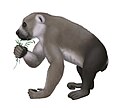古原狐猴科
| 树懒狐猴 化石时期:
| |
|---|---|

| |
| 古原狐猴(Palaeopropithecus ingens)复原图 | |
| 科学分类 | |
| 界: | 动物界 Animalia |
| 门: | 脊索动物门 Chordata |
| 纲: | 哺乳纲 Mammalia |
| 目: | 灵长目 Primates |
| 亚目: | 原猴亚目 Strepsirrhini |
| 下目: | 狐猴型下目 Lemuriformes |
| 总科: | 狐猴总科 Lemuroidea |
| 科: | †古原狐猴科 Palaeopropithecidae Tattersall, 1973[1] |
| 属 | |
古原狐猴科(学名:Palaeopropithecidae),又称为树懒狐猴,为已灭绝的狐猴演化支,包含了四个属[2][3]。树懒狐猴的俗称来自于它们的身体骨架结构特征与现存于南美洲的树懒十分类似,属于趋同演化[4];然而两者之间仍然从有差异,树懒的四肢上具有长而弯曲的爪,而树懒狐猴和其他灵长目则同样有短而扁平的指甲[5]。
食性[编辑]
树懒狐猴主要以水果、坚果与树叶为食[6],但它们并不会因应季节的不同去专一的选择其中一类食物,而是混杂地取食。其中,古大狐猴与古原狐猴具有十分粗厚的下颌骨,食性可能主要以取食叶片为主[4]。
栖息地与多样化[编辑]
颅后特征显示古原狐猴科下的三个属,古原狐猴属、拟大狐猴属、中原狐猴属,主要栖息于树上,并像树懒一样悬吊于树枝上[5]。马达加斯加的河流系统对本科物种形成了良好的地理隔离,有益于异域物种形成,可能也是本科下能分化成四个属的主要原因[7]。
分类学[编辑]
基于形态学,传统上认为古原狐猴科与现存的大狐猴科亲缘关系最为接近,而近年来来自已绝种的大型狐猴DNA分析也证实了这点。除此之外,全部的马达加斯加灵长目物种均来自同一个共同祖先[8]。树懒狐猴的犬齿后牙齿数量(两颗前臼齿及三颗臼齿)与外型均已现存的大狐猴近似。此外,拟大狐猴与中原狐猴的门牙形状近似于大狐猴的齿梳结构,而古大狐猴与古原狐猴的门牙则较为宽厚[4]。从腰椎型态分析显示拟大狐猴能像懒猴那样缓慢的抓住枝干爬行,而其他三属则多半倾向倒挂或悬吊于树上[9]。
灭绝[编辑]

树懒狐猴与其他马达加斯加的大型狐猴的灭绝主因被认为是气候变迁所引起的生态系溃灭。近年研究则显示人类猎杀也可能是这些大型狐猴灭绝的原因之一[10]。曾于这些狐猴的骨骸上有发现过切割的痕迹,可能来自于人类的支解、剥皮行为[11]。种种证据让科学家相信这些大型狐猴是马达加斯加早期居民的狩猎对象[12]。
| 古原狐猴科分类[13](Table 21.1) | 树懒狐猴与其近亲的支序分类图[14][15] | |||||||||||||||||||||||||||||||||||||||||||||
|---|---|---|---|---|---|---|---|---|---|---|---|---|---|---|---|---|---|---|---|---|---|---|---|---|---|---|---|---|---|---|---|---|---|---|---|---|---|---|---|---|---|---|---|---|---|---|
|
参考文献[编辑]
- ^ McKenna, MC; Bell, SK. Classification of Mammals: Above the Species Level. Columbia University Press. 1997: 335. ISBN 978-0-231-11013-6.
- ^ Mittermeier, Russell A.; et al. Lemurs of Madagascar 2nd. Conservation International. 2006: 44–45. ISBN 978-1-881173-88-5.
- ^ Nowak, Ronald M. Walker's Primates of the World. Johns Hopkins University Press. 1999: 89–91. ISBN 978-0-8018-6251-9.
- ^ 4.0 4.1 4.2 Rafferty, KL; Teaford, MF; Jungers, WL. Molar microwear of subfossil lemurs: improving the resolution of dietary inferences. J. Hum. Evol. November 2002, 43 (5): 645–57. PMID 12457853. doi:10.1006/jhev.2002.0592.
- ^ 5.0 5.1 Jungers, William L.; Godfrey, Laurie R.; Simons, Elwyn L.; Chatrath, Prithijit S. Phalangeal curvature and positional behavior in extinct sloth lemurs (Primates, Palaeopropithecidae). Proceedings of the National Academy of Sciences of the United States of America. 1997, 94 (22): 11998–12001. Bibcode:1997PNAS...9411998J. JSTOR 43006. PMC 23681
 . PMID 11038588. doi:10.1073/pnas.94.22.11998.
. PMID 11038588. doi:10.1073/pnas.94.22.11998.
- ^ Godfrey, Laurie R.; Semprebon, Gina M.; Jungers, William L.; Sutherland, Michael R.; Simons, Elwyn L.; Solounias, Nikos. Dental use wear in extinct lemurs: evidence of diet and niche differentiation. Journal of Human Evolution. 2004-09-01, 47 (3): 145–169. PMID 15337413. doi:10.1016/j.jhevol.2004.06.003.
- ^ Gommery, Dominique; Tombomiadana, Sabine; Valentin, Frédérique; Ramanivosoa, Beby; Bezoma, Raulin. Nouvelle découverte dans le Nord-Ouest de Madagascar et répartition géographique des espèces du genre Palaeopropithecus. Annales de Paléontologie. 2004-10-01, 90 (4): 279–286. doi:10.1016/j.annpal.2004.07.001.
- ^ Karanth, K. Praveen; Delefosse, Thomas; Rakotosamimanana, Berthe; Parsons, Thomas J.; Yoder, Anne D.; Simons, Elwyn L. Ancient DNA from Giant Extinct Lemurs Confirms Single Origin of Malagasy Primates. Proceedings of the National Academy of Sciences of the United States of America. 2005-04-05, 102 (14): 5090–5095. Bibcode:2005PNAS..102.5090K. JSTOR 3375184. PMC 555979
 . PMID 15784742. doi:10.1073/pnas.0408354102.
. PMID 15784742. doi:10.1073/pnas.0408354102.
- ^ Granatosky, Michael C.; Miller, Charlotte E.; Boyer, Doug M.; Schmitt, Daniel. Lumbar vertebral morphology of flying, gliding, and suspensory mammals: Implications for the locomotor behavior of the subfossil lemurs Palaeopropithecus and Babakotia. Journal of Human Evolution. 2014-10-01, 75: 40–52. PMID 25216795. doi:10.1016/j.jhevol.2014.06.011.
- ^ Muldoon, Kathleen M. Paleoenvironment of Ankilitelo Cave (late Holocene, southwestern Madagascar): implications for the extinction of giant lemurs. Journal of Human Evolution. 2010-04-01, 58 (4): 338–352. PMID 20226497. doi:10.1016/j.jhevol.2010.01.005.
- ^ Godfrey, Laurie R.; Jungers, William L. The extinct sloth lemurs of Madagascar. Evolutionary Anthropology: Issues, News, and Reviews. 2003-01-01, 12 (6): 252–263. ISSN 1520-6505. S2CID 4834725. doi:10.1002/evan.10123.
- ^ Perez, Ventura R.; Godfrey, Laurie R.; Nowak-Kemp, Malgosia; Burney, David A.; Ratsimbazafy, Jonah; Vasey, Natalia. Evidence of early butchery of giant lemurs in Madagascar. Journal of Human Evolution. 2005-12-01, 49 (6): 722–742. PMID 16225904. doi:10.1016/j.jhevol.2005.08.004.
- ^ Godfrey, L. R.; Jungers, W. L.; Burney, D. A. Chapter 21: Subfossil Lemurs of Madagascar. Werdelin, L.; Sanders, W. J (编). Cenozoic Mammals of Africa. University of California Press. 2010: 351–367. ISBN 978-0-520-25721-4.
- ^ Orlando, L.; Calvignac, S.; Schnebelen, C.; Douady, C. J.; Godfrey, L. R.; Hänni, C. DNA from extinct giant lemurs links archaeolemurids to extant indriids. BMC Evolutionary Biology. 2008, 8 (121): 121. PMC 2386821
 . PMID 18442367. doi:10.1186/1471-2148-8-121.
. PMID 18442367. doi:10.1186/1471-2148-8-121.
- ^ Godfrey, L. R.; Jungers, W. L. Subfossil Lemurs. Goodman, S. M.; Benstead, J. P (编). The Natural History of Madagascar. University of Chicago Press. 2003: 1247–1252. ISBN 978-0-226-30306-2.
外部链接[编辑]
 维基共享资源上的相关多媒体资源:Palaeopropithecidae
维基共享资源上的相关多媒体资源:Palaeopropithecidae
| |||||||||||||||||||||||||||||||||||||||||||||||||||||||||||||||||||||||||||||||||||||||||||||||||||||||||||||||||||||||||||||||||||||||||||||||||||||||||||||||||||||||||||||||||||
|






